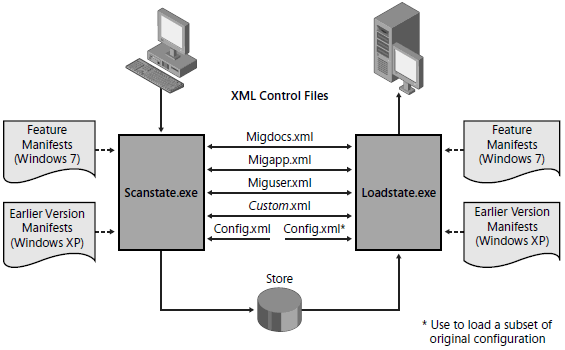Understanding USMT Components
After downloading and installing the Windows AIK, the USMT source files are in C:\Program Files\Windows AIK\Tools\USMT\Platform, where Platform is either amd64 or x86. The installer copies many files into this folder, including .dll files, feature manifests, and other application initialization files. Most of the files support the two main executables: Scanstate.exe and Loadstate.exe.

In addition to ScanState and LoadState, USMT uses three XML migration files-MigApp.xml, MigDocs.xml, and MigUser.xml-to perform basic file and settings migrations based on default criteria. You can customize these files, along with custom .xml files, to migrate additional files and settings or to exclude some of the default files and settings. For more information about migration .xml files.
ScanState and LoadState save and restore user state data, respectively. You can run them directly from a command prompt. They provide several command-line options that control their behavior. USMT 4.0 includes an additional utility called UsmtUtils.exe. This utility helps you to determine cryptographic options for your migration. It also helps remove hard-link stores that you cannot delete otherwise due to a sharing lock.
In this tutorial:
- Migrating User State Data
- Evaluating Migration Technologies
- Windows User State Migration Tool
- Using Windows Easy Transfer
- Refresh Computer
- Replace Computer
- Planning User State Migration Using USMT
- Choosing Subject Matter Experts
- Prioritizing Migration Tasks
- Choosing a Data Store Location
- Automating USMT
- Testing User State Migration
- Installing USMT
- Windows PE Media
- Understanding USMT Components
- Scanstate.exe
- Loadstate.exe
- Developing Migration Files
- Control File Syntax
- Using USMT in Microsoft Deployment Toolkit
- Specifying the Data Store Location
- Adding Custom Migration Files
